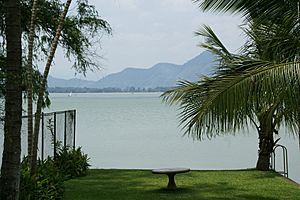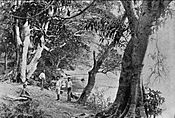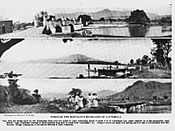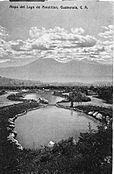Lake Amatitlán facts for kids
Quick facts for kids Lake Amatitlán |
|
|---|---|
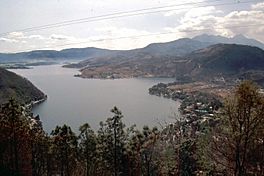
The lake under Pacaya volcano
(in background right) |
|
| Location | south-central Guatemala |
| Coordinates | 14°28′16″N 90°34′54″W / 14.47111°N 90.58167°W |
| Primary inflows | Villalobos River |
| Primary outflows | Michatoya River |
| Catchment area | 368 km2 (100 sq mi) |
| Basin countries | Guatemala |
| Max. length | 11 km (6.8 mi) |
| Max. width | 3 km (1.9 mi) |
| Surface area | 15.2 km2 (5.9 sq mi) |
| Max. depth | 33 m (108.3 ft) |
| Water volume | 0.286 km3 (0.1 cu mi) |
| Surface elevation | 1,188 m (3,897.6 ft) |
| Frozen | Never |
| Settlements | Amatitlán, Villa Canales, Villa Nueva |
Lake Amatitlán (Lago Amatitlán) is a large lake in south-central Guatemala. It sits inside a caldera, which is a big bowl-shaped hollow formed after a volcano erupts and collapses. The lake is quite close to Guatemala City. It is located in the central highlands, about 1,186 meters (3,890 feet) above sea level.
The lake is about 11 kilometers (7 miles) long and 3 kilometers (2 miles) wide. Its deepest point is 33 meters (108 feet), with an average depth of 18 meters (59 feet). The total area of the lake is about 15.2 square kilometers (5.9 square miles).
The main river flowing into the lake is the Villalobos River. Water flows out of the lake through the Michatoya River, which is an important part of the María Linda River system. The town of Amatitlán is located where the Michatoya River begins. A special dam with a railway on top was built at the narrowest part of the lake. This dam divides the lake into two sections, each with slightly different water conditions.
People use Lake Amatitlán for many things. It provides water for homes and farms. It's also used for boats and transportation. Many visitors come to enjoy the beautiful views and for tourism. People also enjoy swimming, fishing, water skiing, and yachting on the lake.
Contents
History of Lake Amatitlán
Early Uses of the Lake
Around the year 1850, Lake Amatitlán was a popular spot for people to visit. It was used as a place for swimming and relaxing, especially during the spring season. Nearby hot springs were also a big attraction for visitors looking to enjoy the warm waters.
Economy and Resources
Seafood from the Lake
In the mid-1800s, Lake Amatitlán was full of different kinds of seafood. There were many crawfish and sardines, along with other types of fish. Local people would catch this seafood. They would then sell it in the surrounding area, as it was rare for seafood to be brought in from other places.
Pollution Challenges
Sources of Pollution
Lake Amatitlán faces serious pollution problems. The area around the lake, called its catchment area, includes Guatemala City. This means that a lot of waste from the city ends up in the lake. Every year, large amounts of untreated sewage (wastewater from homes), industrial waste (waste from factories), and about 500,000 tons of sediment (dirt and small particles) flow into the lake through the Villalobos River.
Effects of Pollution
This pollution has made the lake's water very dirty. It has also led to something called eutrophication. This happens when too many nutrients, like those from sewage, cause too much algae to grow. When the algae dies, it uses up oxygen in the water, harming fish and other lake life. The lake is also experiencing siltation, which means it's filling up with sediment. These problems have greatly reduced the lake's ability to provide clean drinking water and water for irrigation. They have also made it less enjoyable for recreation.
Past Efforts to Clean the Lake
Over the years, there have been attempts to clean Lake Amatitlán. In the early 1990s, a company from Germany started a project to clean the lake using special machines. However, this project was stopped before the lake could be fully cleaned. Later, in 2015, a company from Israel was hired to use a special liquid to clean the lake. This project also faced questions from scientists and environmental groups. As a result, the project was paused, and the special liquid was not added to the lake.
Gallery
See also
 In Spanish: Lago Amatitlán para niños
In Spanish: Lago Amatitlán para niños



